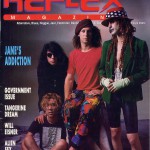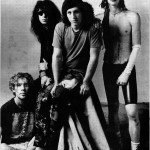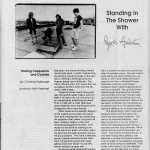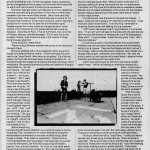Standing In The Shower With Jane’s Addiction
Sharing Cappucino [sic] and Cookies
by Christine Natanael
photos by Beth Hertzhaft
Vol 1, Issue 9
pgs 34-37Standing in the shower thinking of what I should write about, I couldn’t help but sing the words to one of the songs on the new album, Nothing’s Shocking, by the Los Angeles-based Jane’s Addiction. The catchy riffs and lyrics, from one of the most outrageous bands to come from the left coast, made it easy.
Originally formed nearly three years ago, this quartet rapidly made a name for itself in and about the L.A. club circuit as an unpredictable, entertaining live band. Then in 1988, with a major label deal, Jane’s Addiction come barreling out of the underground with a naive ferocity.
Often touted as this decade’s Zeppelin by the majority of journalists who spend more time smoking herb than researching the subjects of their pieces, the group has been maligned, pidgeon-holed [sic], and otherwise packaged by the press. One reason for the cliché floundering is the virtual lack of any public information about the band and the highly guarded mystique the group projects. They have a detached sense of pseudo self-seriousness about them that prevents anyone from really getting inside their heads – and act they seldom welcome to begin with.
Singer/songwriter/artist/photographer/producer, etc – otherwise known as Perry Farrell – sits across an imposing conference table in their management’s office drinking cappucino [sic] and eating cookies. He is a shaded character who speaks well when he speakes [sic] vague. Dressed in black cycle shorts and white combat boots, he sports a child’s idyllic “Bozo the Clown” polyvinyl shirt from a Woolworth’s type Halloween costume, a red Captain Kangaroo blazer, yellow fingerless gloves and blue nail polish. His carefully twisted dreads dangle long below his shoulders and are bright cherry red. His eye makeup is darkly gothic yet striking next to his kabuki paleface and dark lips. Much of his demeanor is affected, but successfully as to hide the real Perry. He speaks deliberately and slowly so as not to be misquoted.
“The whole thing is I don’t really want people to know that much about me,” claims the charismatic entertainer. “It’s hard to do interviews because… well, they’re important to me, but I think it’s almost like repeating yourself – to be a musician and then do an interview. We’re saying what we want to have said in our music. That’s the kind of band we are. If one doesn’t enjoy being obvious, one becomes a musician to not be so obvious. I can stil [sic] relate to the questions, but people want me to be obvious in interviews. That is why I don’t enjoy it. It’s like repeating what has already been said in a subtle way. The interviewer says, ‘well… tell me that again, but in a real obvious way,’ and so I say, ‘man, I’ve tried hard my whole live not to be obvious.”
To be obvious for Perry is to travel to the vortex of mundane mediocrity. It is an exercise in creative restraint, (anyone can be obvious). An example of this avoidance of the expected can be seen as soon as the subject of their press kit comes into the conversation. Even in that medium, which is usually the front line of communication between record company, artist, and journalist, Jane’s Addiction shred tradition and turn in their own six page biography complete with typographical errors and twisted elementals. Upon reading this transmission from the nether regions of Hollywood, what wasn’t said was most important. It’s there for those who have a keen sense of common knowledge.
The members of Jane’s Addiction are four very different and talented young musicians. Their variations and degrees blend and seperate [sic] seemingly without notice and upon their own sporadic sense of timing. In an effort to have them open up and reveal some substance, I delved back in time searching for the moment that originally brought this cacophonic entity together. What I found is that Perry is as guarded and elusive about his past as he is about his music. I did manage to drag some facts out of him, though. It seems the band’s current line-up came together when Jane (yes, she does exist) introduced Perry to bassist Eric Avery. Farrell – emerging from Psi-Com, his previous band – was looking for some new musical activity. After meeting Avery, they began to work together and added guitarist Dave Navarro and drummer Steve Perkins – who had both been in a previous band with Eric.
Each of the guys tossed a few anecdotes my way to satisfy my journalistic queries, but to better glean anything from these lads, it’s necessary to properly introduce them.
Bassist Eric Avery looks and acts like a scene-making, intellectually artistic, and musically alternative East Village resident. With his short hair, black felt hat, beaming smiles and earnest stare, he could be the kid of that slightly odd neighbor of yours.
“I don’t think I said more than three syllables before the age of twelve,” laughs Eric. “I managed to spit out about fourteen words after the age of twelve. I started playing guitar in those monosyllabic years when I discovered my dad had these Gimon and Sarfuncle (sic) books. You know, the how-to-play kind. He also had a Burl Ives how-to-pay book. I didn’t have anything else to do with myself except sit in my room because I was monosyllabic, so I started playing guitar a bit. Then I started playing bass and making rock and roll.”
Drummer Steve Perkins looks like the all-American boy-next-door. I’m talking about a squeaky-clean sort of guy with a wild shock of dirty-blonde springy curls and sparkling blue eyes. He is the quietest of the group, interjecting only as a topic excites him. He’s the type of guy you would hardly expect to see in an eclectic group like Jane’s Addiction. He seems somehow out of place yet a concrete part of the kaleidoscope that is this group. The barbed comments, entendre, and double talk roll off his back as normality – because for him it is. Listening to his playing, many images come to mind – from the most clichéd and antiquated John Bonham hard hitting style, to the most unlikely Mickey Hart/Grateful Dead, Amerindian tribal patterns. His playing doesn’t just stick to keeping time. It makes a statement and punctuates itself.
Guitarist Dave Navarro is an exotically handsome young man of Spanish/Italian/Dutch extraction. He and Steve have known each other, played music together, and been best friends since they were in high school. He is a shy and shaded sort of burgeoning virtuoso – almost painfully so – who spends most of his time playing with instruments and always has.
“When I was thirteen I was in a band called South Dakota Railroad,” related Dave. “We played Hendrix and Cream songs – things like that – and it was really horrible. It was the worst sounding band in the world, but it was fun. Later on I met up with Steve in high school in a metal band called Disaster – which it was. I got carried away with it and that’s all that I was really interested in after a while. It’s all I was good at. People always complimented me and I loved it. Steve and I actually played in a band with Eric once, before Jane’s Addiction was even a glimmer in our eye. As for Jane’s, I think we all just kind of found each other in a roundabout way, and I don’t know why. It all just happened.”
Whatever it was that happened, it surely seemed to turn on the A&R people over at Warner Brothers – as well as a few other companies. According to Perry, Warner Brothers seemed hot on the project from the start, and after a long round of negotiations, Jane’s Addiction became the first indie band from Triple X Records to be signed to a mega-deal with Warners. What’s more, all of this attention came after only one previous album, the self-titled live LP on XXX, and tracks on the Scream compilation and Dudes soundtrack. From the band’s own admission, the bidding wars were quite nasty, but they came out of the deal with a sufficient budget to do exactly what they wanted on their first major label release.
“It was the easiest thing,” grins Perry with a shrug as he munches on some fancy cookies. “It just happened. I don’t know what it was and I couldn’t tell anybody what it was if I wanted to. People just dug it and the record companies saw it and wanted to make money with it, and we just got our choice of record companies. We got enough money to make a record that we wanted to make without having to run out of dough and call it quits. We used all the money that they gave us to record they album. It is important not only for us, but for a lot of people behind us.”
“We started with the idea that we wanted to be an indie band,” Farrell continues, “and we could have remained an indie band. It wasn’t so much the money, it was the organization that Warner Brothers has. They are just as cool as some of the indies – even cooler in a lot of ways. It’s just that they’re more organized and we’re not getting ripped off. I mean, who suffers but the band for a label’s mistakes? Time and time again, they don’t have enough money and the band immediately suffers because of it. It’s either make up your own label and live on a small budget or move to one that’s organized, honest, and most importantly, artist oriented.”
Artist orientation was a big chunk of what Perry was looking for, and that’s apparent all over the album. He wrote all the lyrics, co-produced the music, shot the photographs (with the help of Casey Niccoli), and designed and cast the sculpture of the nude siamese twins in a rocking chair with flaming hair (and don’t forget the pierced nipple) that adorns the album’s cover. A true underground renaissance man, Farrell may appear vague, mysterious, and as changeable as litmus paper, but he knows definitively what he wants and how he wants his band to be represented.
The cover itself garnered much attention and many objections from the ultra-right wing groups that run the nations middle class polyester-nightmare record chain stores. (Must have been that nipple ring, boys, how risque! [sic]). Farrell deserves an award for his refusal to bend under (or is that over?) pressure, and for fighting to protect his firm stance for his own first ammendment [sic] rights. Despite urgings from many circles to change the album cover artwork, Perry stood tall and the jacket was printed exactly as designed. According to Perry, if his art is immoral, then so is that of Picasso, Matisse, and Michaelangelo. It’s all really just a true question of taste, most of which is only in the mouths of those trying to pass judgement [sic].
“I love doing art,” states Perry.
“There’s a big difference between being into art and doing art,” interjects Dave.
Not to be satisfied with a mere statement, Perry goes on to explain and defend what he means. “There’s this guy who lives next to me,” says Farrell, “ who owns an art gallery. It’s a little art gallery, but he thinks he knows every fucking thing about art. I’m looking through this magazine he’s got on the table, and I say, ‘that’s really pretty.’ He knows all the famous artists and I asked him if the guy responsible for the art was famous. He said, ‘yeah, but I hate his art. It doesn’t… you know… whatever…’ But I really thought it was beautiful. Then there was another page and he goes, ‘oh, now you see that’s great’ and I swear to God it was a black and white striped square with paisley inside it. He says, ‘this guy is pushing things.’ I said ‘I would gladly wipe my ass with that and wouldn’t think twice before flushing.’ The guy was so caught up in what he thought should be beautiful. And to think, that’s reality to him.”
Almost everything having to do with Jane’s Addiction is a matter of reality or opinion. Songs like “Ted, Just Admit It” or “Idiot’s Rule” give a poignant socio-political commentary on the state of affairs today, albeit tongue in cheek. They need no explanation. Others such as “Summertime Rolls” and “Jane Says,” that have been so pointed out by the blind press, are simple outpourings of emotion, passion, love and reminiscence. SO much so, that when asked, Farrell gives the stone face answer of, “don’t ask me about Jane. I don’t really have any comments about her. She’s a very private, different person.”
On the whole, the title Nothing’s Shocking is the timely and supreme description of life in the late ‘80s and not just what is preserved in the grooves of the vinyl. Their live show is a sensual ecstatic overload of distortion, primitive rhythms and sing-a-long lyrics combined with a starint-from-the-‘60s psychedelic ink-blot-transparency light show. The guys of Jane’s Addiction are entertainers in the largest sense of the word. They strive not to play to an audience, but to play with and audience. Their previously mentioned bio claims that after shows “people attest to feeling as if they let a stranger touch them.” What is closer to the truth is a disturbing feeling of having had subliminal sex in a public place. Their New York City show at the World was an exercise in excess. Between the hot sweat anticipation of the crowd and the energetic, pseudo-religious deliverance of the band, there was an insane curioso magic at work.
“I turned around, saw the twins on the wall and freaked. I asked, ‘what the hell is going on?’” says Perry of that show. “I was there and I didn’t even know it. The only thing I remember is smashing Dave’s guitar and feeding it to the audience.”
“I didn’t even see where it went,” says Navarro in a surprised tone. “I met a girl who had been to the show and she said she had seen this guy afterwards just holding onto it as if he was going to sleep with it. I hope he does. It was the only guitar I had. I don’t have any backups.”
It is just that gung-ho minimalist attitude that moves Jane’s Addiction over the boundary lines that society and the recording industry try to impose. They live this lifestyle and don’t just act it onstage. Epitomizing alternative crossover, their crowds are a strange brew of goth, alternative, and metal fans. Yet, they are quick to point out that they are not a metal band – despite the fact that Dave and Steve both have roots there.
“I don’t have anything to do with the metal scene myself,” states Farrell. “We’re not making an intentional mockery of it, either. If you mock it, that’s just five less notes you have for something good. Can you tell me why people always thing we are making fun of everything? Do we come off like we’re sarcastic?”
Their first indie record had a sort of “metallic” sound, but only because it was a younger more raw version of the group. It was metallic in the ‘60s sense of the word, (don’t forget Dave’s affinity for Cream and Hendrix). But what makes the band innovative now is the fact that they take a ‘60s guitar sound and warp it out with ‘80s technology, adding Perry’s “unobvious” phrasings to totally confuse an entire generation.
“I’ll tell you what the truth is,” says Perry. “I just really want to see big hairy dudes trying to dress like me. That’s what we’re really after. We’re out to start a trend, and then big hairy dudes will have to do it because it will be the thing to do. You’ll see these big hairy dudes walking around in girdles and shit. That’s really what – if you want to know, if you want to get to the bottom of all this and tell the public what it is we’re trying to do – we’re trying to get some big hairy dudes in girdles.”
Yep, that’s right, Perry, and nothing’s shocking.
- Cover
- Page 1
- Page 2
- Page 3
- Page 4






You must be logged in to post a comment.